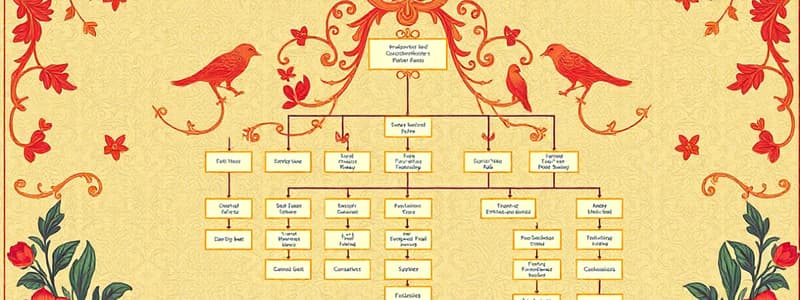Podcast
Questions and Answers
What is one advantage of a tall organisational structure?
What is one advantage of a tall organisational structure?
- Flexible communications flow
- Less hierarchy in the organization
- Small span of control for supervisors (correct)
- Faster decision-making process
A flat organisational structure typically has a long chain of command.
A flat organisational structure typically has a long chain of command.
False (B)
What is one type of organisational structure suited for restaurants?
What is one type of organisational structure suited for restaurants?
Flat Structure
In a tall organisational structure, the flow of _________ can be slow due to the many layers of management.
In a tall organisational structure, the flow of _________ can be slow due to the many layers of management.
Match the following structures with their characteristics:
Match the following structures with their characteristics:
What is a key advantage of a flat organizational structure?
What is a key advantage of a flat organizational structure?
In a matrix structure, employees may face conflicts of interest across projects.
In a matrix structure, employees may face conflicts of interest across projects.
Name one disadvantage of a flat organizational structure.
Name one disadvantage of a flat organizational structure.
A matrix structure is ideal for a business that works on a __________ basis.
A matrix structure is ideal for a business that works on a __________ basis.
Match the following aspects of matrix structure with their descriptions:
Match the following aspects of matrix structure with their descriptions:
Flashcards
Tall Structure
Tall Structure
An organizational structure with many levels of management and a long chain of command.
Flat Structure
Flat Structure
An organizational structure with few levels of management and a short chain of command.
Organizational Chart
Organizational Chart
A visual representation of an organization's structure, showing roles, responsibilities, and reporting relationships.
Span of Control
Span of Control
Signup and view all the flashcards
Chain of Command
Chain of Command
Signup and view all the flashcards
Flat Organizational Structure
Flat Organizational Structure
Signup and view all the flashcards
Disadvantages of Flat Structure
Disadvantages of Flat Structure
Signup and view all the flashcards
Matrix Organizational Structure
Matrix Organizational Structure
Signup and view all the flashcards
Matrix Structure Advantages
Matrix Structure Advantages
Signup and view all the flashcards
Matrix Structure Disadvantages
Matrix Structure Disadvantages
Signup and view all the flashcards
Study Notes
Types of Organisational Structure
- Organisational charts visualize employee roles, reporting structures, and responsibilities within a company or group.
- Charts show departments (e.g., production, finance, marketing, HR).
- They depict job titles (e.g., Directors, Managers, Supervisors).
- Charts outline responsibilities and duties.
- Charts illustrate lines of authority (who reports to whom).
- Charts display communication flow (vertical and horizontal).
- Charts show chains of command.
Suggested Activity
- Create an organisational structure diagram representing your personal relationships (family, friends).
- Draw a diagram illustrating the roles and reporting structures within a team, club, or organisation.
What Does an Organisational Chart Show?
- The chart displays departmental names (e.g., production, finance).
- It shows job roles (e.g., managers, supervisors).
- The chart outlines responsibilities and accountabilities.
- It depicts lines of authority (who is in charge).
- The chart illustrates communication flows (who communicates with whom).
- It shows chains of command (who is at the top).
Different Types of Organisational Structures
- Common structures include Tall, Flat, and Matrix.
- Understanding these structures is crucial for the Edexcel exam.
- Drawing the structures is not required; understanding the differences is essential.
Tall Structure
- Tall structures offer numerous promotion opportunities.
- Decision-making processes can be slow due to multiple layers of hierarchy.
- Workload is distributed among many individuals, reducing stress on any one person.
- Clear hierarchical structure promotes order and organization.
Tall Structure Advantages
- Supervisors have a narrow span of control, allowing them to develop strong relationships with subordinates.
- Subordinates can be effectively mentored.
- Tasks are well-defined and delegated, leading to a well-trained team.
Tall Structure Disadvantages
- Multiple layers create a lengthy chain of command, hindering quick decision-making.
- Communication flow can be slow and inflexible.
- Extensive layers increase management and support staff costs.
Flat Structure
- Flat structures are common in fast-paced environments, such as restaurants and web design companies.
- Information flows rapidly. This structure is efficient.
- Fewer levels result in quick communication.
- Wide delegation promotes greater employee responsibility.
Flat Structure Advantages
- Fewer layers expedite communication between top and bottom levels.
- High delegation levels empower staff with greater job responsibility.
- Many opportunities for staff to showcase their talents.
Flat Structure Disadvantages
- Managers may struggle to oversee a large number of employees.
- Staff may feel overwhelmed by a lack of direction or support.
- Conflicts of interest may arise related to responsibilities or roles, as managers are rarely present.
Matrix Structure
- Matrix structures are ideal for companies with multiple projects or products simultaneously.
- It allows staff to contribute to multiple tasks across different areas or departments, utilising their skills.
- It enhances efficiency and agility.
Matrix Structure Advantages
- Very flexible in terms of how staff are assigned among projects or departments.
- Specialised skills can be used effectively.
Matrix Structure Disadvantages
- Conflicts may emerge between employees or departments due to responsibilities across projects.
- Staff may feel stretched across projects and lose focus within their departments.
- Co-ordinating projects can be complex and difficult.
Studying That Suits You
Use AI to generate personalized quizzes and flashcards to suit your learning preferences.



